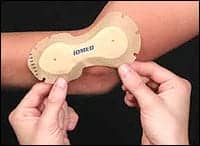 |
| Iontophoresis patches use electrical current to facilitate delivery of therapeutic agents into inflamed or painful tissues. |
What do electric eels, rabbits, and sweaty feet have in common? All are chapters in the long story of the development of modern clinical iontophoresis. The first record of the therapeutic use of electricity is a reference to ancient Greek physicians who placed electric eels in footbaths to relieve pain. In the mid-19th century with the invention of the battery and the induction coil, there was renewed interest in medical applications of electric current, including extensive study of its use to deliver medicaments and metal ions through the skin to treat a wide range of medical conditions.
In 1903, Stéphane Leduc demonstrated using rabbits that the delivery of drug ions and not the electric current was the basis of iontophoretic effects. However, lack of safe, standardized iontophoresis equipment inhibited widespread adoption of iontophoresis as a practical treatment method. Sweaty feet? Iontophoresis with ordinary tap water is recommended by dermatologists as an effective treatment for excessive sweating (hyperhidrosis) on the soles of the feet, palms of the hands, and underarms, presumably because of the effect of current on ion transport in the skin. Today, numerous drugs have been delivered therapeutically across the skin and into the bloodstream using iontophoresis. The delivery can be either site specific or systemic, depending upon the mechanism of action of the drug and the total iontophoresis dose delivered.
THERAPEUTIC USES OF ELECTRICITY
Iontophoresis is distinguishable from other applications of electric energy in rehabilitation medicine (transcutaneous electric nerve stimulation or TENS, interferential current therapy or IFC, galvanic stimulation, etc) in that with these electrotherapy methods the current itself is therapeutic. With iontophoresis, electric current is used to transport therapeutic agents into target tissues, most often to treat acute local inflammatory conditions, but is also used to soften scar tissue, for local pain control, and to reduce calcium deposits.
PRINCIPLES OF IONTOPHORESIS
Iontophoresis is a drug delivery method that uses low-level direct current in the milliampere (mA) range to transport drugs and other water-soluble salts through and into tissues of the body. Iontophoretic dose is usually defined as current multiplied by time of application: Dose (mA-minutes) = Current (mA) x Time (minutes).
 |
| An iontophoretic dose controller enables a physical therapist to adjust the preferred levels of medication to be delivered by a dispersive patch. |
Controlled laboratory experiments have demonstrated that the amount of a drug delivered is directly proportional to the iontophoretic dose applied. There are practical limitations depending on the drug, the iontophoresis system used, and the sensitivity of a patient’s skin to electric current, but in general the relationship of current and time permits considerable flexibility in treatment protocols.
Iontophoresis is most effective in delivering water-soluble, ionic (charged) medicaments. Ionic derivatives of a drug, such as dexamethasone sodium phosphate and lidocaine hydrochloride, should be used. Many drug formulations used for iontophoresis are available directly from pharmacies in aqueous formulation, including those labeled “For Injection.”
Alternatively, custom formulations containing fewer preservatives and other competing ions may be obtained by prescription from compounding pharmacies. Therapists should inform physicians of these requirements when requesting drug prescriptions for patients.
The charge or polarity of the medicament to be delivered using iontophoresis will determine whether the positive or negative lead wire is connected to the drug-containing patch. One of the fundamental principles of iontophoresis is that ions move away from patches of like charge. Lists of drugs delivered by iontophoresis and their polarities have been compiled and are generally available in published literature. Most commercial iontophoresis systems allow current polarities to be switched between positive and negative to accommodate both cationic (+) and anionic (-) drugs.
CLINICAL IONTOPHORESIS SYSTEMS
Commercial iontophoresis systems are comprised of a reusable iontophoretic dose controller and a single-user, disposable treatment kit. The dose controller is a microprocessor-controlled, battery-powered direct current source, which delivers current at a preset level or at levels that can be adjusted by the physical therapist to accommodate various treatment protocols. The treatment kit contains a drug patch and a dispersive patch. The drug patch is hydrated by the therapist immediately before use with a volume of drug solution specified by the manufacturer. The dispersive patch, which completes the electrical circuit through the skin, is usually a conductive polymer that can be used without further preparation, or it may require hydration with saline before use.
In traditional iontophoresis systems, a clinician places the drug patch on the patient at the site to be treated. The reusable dose controller is connected to the drug and dispersive patches using lead wires. Both the current level and treatment time can be adjusted to deliver a typical 40 to 80 mA-minute dose over 10 to 20 minutes, offering maximum flexibility in dosing regimens. Although these systems are cost effective and offer precise dose control, they limit patient mobility during treatment.
Recently, disposable integrated iontophoresis patches containing a low-level current source have been introduced. These integrated patches, which are applied directly to the treatment site, allow the patient to be ambulatory during treatment, thereby increasing productivity in the clinic and offering convenience to the patient. However, due to their low and unregulated electrical output, these patches must be worn for as long as 24 hours to deliver a total iontophoretic dose of approximately 80 mA-minutes. The main disadvantage of these patches is a lack of controlled drug delivery.
New innovative iontophoretic systems coming to market will combine controlled drug delivery with the convenience of integrated patches. These new systems will offering clinicians and patients the broadest range of treatment options to meet their iontophoresis needs.
Thomas M. Parkinson, PhD, is a medical device and pharmaceutical products consultant, specializing in the development of novel oral and transdermal drug delivery systems. Most recently, he was VP of research and development at a leading developer and marketer of clinical iontophoresis systems. He currently hosts an “Expert Insight” column on iontophoresis on this web site
For more information, contact .
BIBLIOGRAPHY
- Banga AK, Chien YW. Iontophoretic delivery of drugs: fundamentals, developments, and biomedical applications. J Control Release. 1988;7:1-24.
- Iontophoresis protocols for treating common conditions of soft tissue injury and inflammation have been compiled by Iomed Inc, in collaboration with experienced practicing physical therapists; www.iomed.com.
- International Hyperhidrosis Society, Suite 1160, 520 Walnut St, Philadelphia, PA 19106; .
- Substances Delivered by Iontophoresis as Reported in the Literature. Compiled by Iomed Inc, Salt Lake City, UT 84120; www.iomed.com.
- Zempsky WT, Ashburn MA. Iontophoresis: noninvasive drug delivery. Am J Anesthesiol. 1998;25:158-162.





